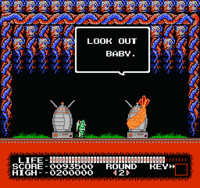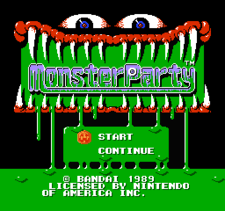Monster Party
| Monster Party | |
|---|---|
|
North American cover art | |
| Developer(s) | Human Entertainment |
| Publisher(s) | |
| Platform(s) | NES |
| Release | |
| Genre(s) | Platform game |
| Mode(s) | Single player |
Monster Party is a video game for the NES, released in North America in 1989 by Bandai. It was and remains a relatively obscure platform game for the console, having a small following among some players. The game both pays homage to and parodies horror pop culture, alternately featuring enemies and locations based on classic horror icons, and parodic reinterpretations.
In the 2000s the game became infamous in online gaming circles when prototype screenshots of a Japanese Famicom version known as Parody World: Monster Party (パロディワールドモンスターパーティー Parodi Wārudo Monsutā Pātī) began circulating showing different bosses and parodies. No version of the game was ever released in Japan.[1] On May 26, 2011, a prototype of the canceled Japanese release was listed on Yahoo! Japan auctions, closing at a very high price of ¥483000 (approximately $6000 in American dollars).[2] On July 3, 2014, the unreleased Japanese Famicom version was leaked online.[3]
Story
The story centers on a child named Mark who, on his way home from a baseball game, is approached by a winged, gargoyle-like alien named Bert who seeks assistance in ridding "evil monsters" from his realm, "Dark World".[1] Being the first person he encounters, Bert tries to enlist Mark as his aid in battle. Mark is reluctant to help, but Bert explains that anyone will do, and that Mark's baseball bat will be as good a weapon as any. Bert quickly whisks him away, and on the way to Dark World magically fuses himself to Mark so that they are one being (with Mark able to transform into Bert for a limited time).
The bizarre premise and plot introduction sets up a game that is filled with variations on many traditional horror characters and themes (sometimes with ironic twists), as well as relatively novel [1][4] characters all its own. Some traditional horror bosses the game features include a mummy, giant spiders, zombies, Medusa, a Dragon, and The Grim Reaper. The game also features several enemies drawn from Japanese folklore and Japanese urban legends, such as Banchō Sarayashiki's well and Jinmenken (human faced dogs). Enemies unique to the game include a large, talking caterpillar; walking pants; a giant cat that hurls kittens as projectiles; and a bouncing piece of fried shrimp.
After making his way through Dark World and ascending into what appears to be some kind of Heavenly realm, Mark fights and defeats the Dark World Master. His realm now free of monsters, Bert returns Mark home and leaves him with a parting gift for his help. When Mark opens the box, a beautiful princess emerges; after a few seconds, though, she transforms into a hideous monster who melts Mark's flesh from his bones.
Mark suddenly awakens in his bed, his body intact. Believing his adventures in the Dark World was a dream, he prepares to leave the house to school, only to find Bert standing before the front door with Mark's bat. Bert asks Mark if he is ready to go again, and the game ends.
Gameplay

The player takes the role of Mark, who wields his bat to attack and to deflect projectiles. Rebounding projectiles back at bosses is often necessary to defeat them as Mark, as he otherwise has limited attack options. Enemies drop hearts, which replenish life, as well as pills which (for a small period of time) turn Mark into Bert, who can fly and shoot beams a limited distance. The effect of Bert's beams on enemies is stronger than Mark's bat attack, and gradually improves as the player completes levels.[1]
Monster Party features eight levels, each of which has a unique password that allows the player to access a particular level without starting the entire game over. The basic objective in each level is to beat particular bosses (and a certain number of them) to earn a key and move on to the next level. Bosses are accessed by doorways found in the main part of the level, which is side-scrolling. However, many of these doors lead to empty rooms, adding challenge. Every door, whether it leads to nothing or a level boss, gives the player a question mark ('?') item, which can either provide the player with health, points, or transformation into Bert.
| Reception | ||||||
|---|---|---|---|---|---|---|
| ||||||
Levels
- Dark World: Initially a grassy, mountainous region with blocks bearing smiley faces. After passing a haniwa statute at the midway point, lightning strikes, the faces melt into bloody skulls, and the world becomes a hell environment.[4] The bosses for this level are a Man-Eating Plant, a giant dead spider (no fighting necessary, as its dialogue box "SORRY, I'M DEAD" confirms), and a pumpkin-headed ghost who throws smaller pumpkins and wants not to be picked on.
- Dark World Dungeon: A sewer-like area infested with fish heads, crocodiles, and a blood-belching creature. Bosses for this level include a Medusa; Shrimp Attack; and a haunted wishing well that throws plates (a reference to the Banchō Sarayashiki ghost story).[1]
- Dark World Cave: Bosses for this level include the Guardian of the Giant Sphinx, who complains that his legs are asleep; a Giant Spider; and the Giant Cow Man, whose attack is smaller cows.
- Dark World Castle Ruins: A pyramid-like area with desert enemies, such as scorpions. Bosses include Giant Samurai, who is slow-moving and admits it in its dialogue box; a giant cat; and Punk Rocker.
- Dark World Lake: This area has two bosses instead of the usual three. Enemies include sharks with large fins and sea serpents. Bosses are The Walking Dead (a pair of invincible, dancing zombies who automatically deteriorate if the player simply watches them perform); and Mad Javelin Man, a large wooden robot.[1]
- Dark World Haunted Mansion: A large maze that must be navigated. There is only one boss here, Chameleon Man, a giant, reptilian head that blends into its environment.
- Dark World Tower: An upward scrolling tower. Amongst gamers, the level is notorious for a bug that renders the game unwinnable if all three bosses are defeated; the player must only beat two and then proceed to the end of the level in order to beat it. Beating all three bosses will result in the player losing the key.[1] Enemies include umpires, masked elephants, and imps. Bosses include a caterpillar named (Rolls) Royce; the Grim Reaper; and the return of the Giant Spider, with a Roman numeral II on its back.
- Dark World Heaven's Gate: A heaven-like area that defies the conventions of platformers by having a "hidden" area to the left of the starting position. Enemies include dynamite and witches. Bosses are a Pharaoh's Head; Hand Man; and Giant Dragon.
After beating the eight levels, the player faces the Dark World Master, seen only as an angry giant zombie face that shoots flying eyeballs. His nose opens into another eye, his only weak spot.
Legacy

Monster Party is infamous in the retro gaming community for prototype images released in Japan before the game's release in the US. The images reveal a different original concept for the game that was much darker and more graphically complex than the version eventually released. Originally, the title screen was to be covered in blood, and the enemies designed to look much more horrific than in the final game.[1][4] The first level's setting, presently an abstract black-and-pink pattern, was originally an elaborately drawn mountain range at sunset. Other changes revealed by these images is a change to the first boss, a large plant, which was shown to have a microphone and speaker in the original, a possible reference to Little Shop of Horrors.[5]
The game is remembered for its bizarre premise by both fans and critics alike.[6] The horror content that was permitted to remain in the game—notably large amounts of blood and the use of the word "hell"—have puzzled gamers, as Nintendo was notorious for enforcing censorship policies in the late 1980s and early 90s, when the game was released.[1][6]
In the latter 2000s, following the release of prototype images, gamers realized that an invisible platform inside the man eating plant's chamber was in fact the "deleted" speaker system, and that programmers had simply covered the sprite in black pixels rather than outright remove it. This led to the establishment of a restoration project, in which gamers began searching through the game's source code in attempt to discover if other "deleted" content had in fact remained on the cartridge, and reinsert it into a "restored" version of the game. As of 2011 the project is still underway. Amongst discoveries made by those working on the project was the revelation that many of the game's more incongruous bosses may have originated as copyrighted characters that had to be altered for the game to be released in the United States: The pumpkin ghost with the spinning head was originally an ape from Planet of the Apes, while the giant cat inside of the box seems to have originally been one of the Gremlins, and finally the grim reaper was originally an alien from the Alien franchise.
References
- 1 2 3 4 5 6 7 8 9 Strangman, Rob (September 2009). "Monster Party at Hardcore Gaming 101". Retrieved 2009-09-24.
- ↑ GameSetWatch (June 9, 2011). "Japanese Monster Party Prototype sells for over $6,000". Retrieved 2011-06-10.
- ↑ Nolan, Mark (July 3, 2014). "You Are Cordially Invited To The Parody World: Monster Party". Nintendo Player. Archived from the original on July 15, 2014. Retrieved July 3, 2014.
- 1 2 3 Encyclopedia Obscura (November 2002). "The Horror!". Archived from the original on 2009-09-25. Retrieved 2009-09-24.
- ↑ Unseen64 staff (August 7, 2008). "Monster Party [NES – Beta]". Retrieved 2009-09-25.
- 1 2 "Monster Party – NES". November 2005. Retrieved 2009-09-25.
External links
- Monster Party – Digital Press Online Review of Monster Party at Digital Press Online.
- Monster Party – Bandai Shows screenshots of the Famicom prototype in comparison to the NES version.
- Monster Party at MobyGames
- Monster Party Review Review of Monster Party at Flying Omelette, with several screenshots.
- Syd Lexia on Monster Party Review of Monster Party with screenshots of all bosses.
- Monster Party Beta Restoration Project